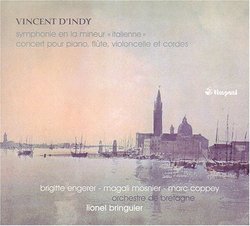| All Artists: D'Indy, Orchestre De Bretagne, Bringuier Title: Symphony & Concerto Pour Piano Flute Members Wishing: 1 Total Copies: 0 Label: Timpani Original Release Date: 1/1/2008 Re-Release Date: 4/29/2008 Album Type: Import Genre: Classical Styles: Chamber Music, Forms & Genres, Concertos, Historical Periods, Classical (c.1770-1830), Symphonies Number of Discs: 1 SwapaCD Credits: 1 UPCs: 675754007249, 3377891311254 |
Search - D'Indy, Orchestre De Bretagne, Bringuier :: Symphony & Concerto Pour Piano Flute
 | D'Indy, Orchestre De Bretagne, Bringuier Symphony & Concerto Pour Piano Flute Genre: Classical
|
Larger Image |
CD Details |
CD ReviewsA second Italian symphony? Who knew? Larry VanDeSande | Mason, Michigan United States | 08/22/2008 (4 out of 5 stars) "Frenchman Vincent d'Indy (1851-1931) certainly qualifies as one of classical music's minor composers. I owned an LP with his most famous work on it back during the epoch of long playing records and never again -- until today -- did I purchase anything by him. When I contemplated buying this recording, I checked him out in several publications -- the 2005 edition of the All Music Guide, the 2008 Penguin Guide, and the one and only (published 2000) copy of Third Ear Classical Music, which had the most complete section on his prior recordings.
Many are aware of d'Indy's hybrid piano concerto-symphony called Symphony on a French Mountain Air, of which the new Penguin Guide lists several reviews written under its French title -- Symphonie sur un chant montagnard francais (Symhonie cevenole.) That publication only lists one other recording by this composer, of chamber music. Incredibly, the published All Music Guide (I did not consult the online version) does not even have a section on this composer. Third Ear has 3-4 paragraphs, most on the Symphony on a French Mountain Air and his chamber music. They also reference several versions of a "Symphony 2" he wrote; that apparently is not this recording. This is an earlier, juvenile symphony d'Indy wrote that was inspired by a trip to Italy and a painting of Mendelssohn he saw in a hotel, the notes tell us. The composer declared it a personification of Italy in four parts, all named for Italian cities -- Rome (andante maestoso); Florence (allegro vivace); Venice (andante); and Naples (Salterello, allegro ma non troppo). I'm not sure the composer achieved his goal of characterizing Italy...and I am certain he did not achieve his secondary goal of musically painting the victory of Christianity over Paganism in the Rome movement! All told, it consitutes a lively program -- not as overtly programmatic as Ibert's "Escales" -- constructed on solid counterpoint and memorable ideas if not always memorable tunes. Next is a triple concerto for piano, flute, cello and chamber orchestra, the composer's Op. 89. This is far more modern than the conservative 19th century symphony with strong pre-echoes of the new French music to come from the likes of Poulenc and Milhaud. The booklet says, "D'Indy's musical gods were Germanic: Gluck, Beethoven, Meyerbeer and, of course, Wagner." You'd never know it by listening to this concerto. While sounding eminently French, there is a three bar piano solo in the first movement as chromatic as anything Wagner wrote. Yet, this is an interim transition in the jollity that overwhelms the movement, which is marked Modere, mais bein decide. A lovely and tuneful middle movement (Lent et expressif) that gives each soloist time in the spotlight follows, and the symphony wraps up with an energetic concluding movement (Mouvement de ronde francaise) in rondo form. The playing, by Orchestre de Bretagne (Orchestra of Brittany, founded in 1989) under conductor Lionel Bringuier, is always bracing and sympathetic, very French, and altogether delightful. The concerto soloists are also sympathetic. The orchestra is not of the first rank, though. They demonstrate this in a section of the symphony's opening movement where low brass follow woodwind (principally flute) phrases where the horns and tubas hardly toot much less bellow. Still, it's clear the players had the times of their lives with this newly-minted recording of their countryman. The sound is equally good, wide-ranging and detailed although without the depth you'd expect from the best recording. French notes somewhat poorly translated to English round out a solid package that comes in a hard cardboard tray with formed plastic insert for the disk and a removable 16-page booklet of notes by Michel Stockhem and bios on the performers. While this isn't likely to topple the next great "Eroica" from the charts or earn a place on a list of exalted recordings of 2008 -- although it may have a place in mine -- this is nevertheless a lively, interesting and unusual slice of a composer not well-known and rarely recorded. I'd recommend this to anyone who enjoys French orchestral music and/or those that enjoy pursuing recordings slightly off the beaten path. Note: even though Amazon says this is not in stock, they shipped mine within a few days of my order and I had it in a week." |

 Track Listings (7) - Disc #1
Track Listings (7) - Disc #1